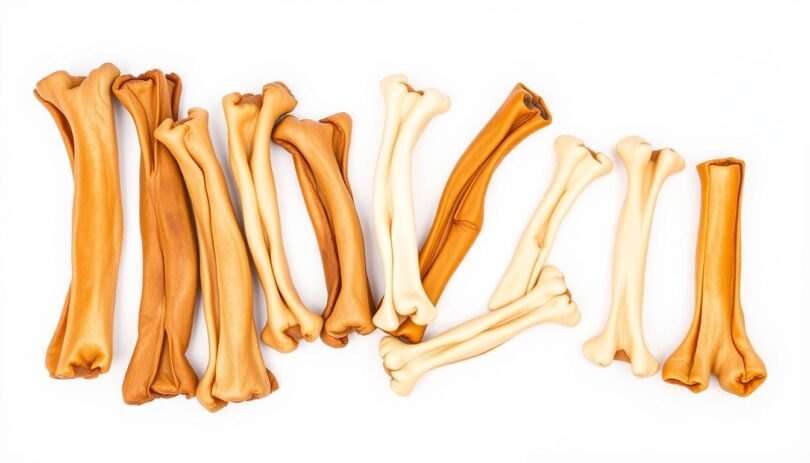What if a popular dog treat could do more harm than good? Many pet owners rely on traditional chews to keep their companions entertained, but growing concerns about safety demand a closer look. While these products offer benefits like dental cleaning and mental stimulation, hidden dangers lurk beneath the surface.
Chewing habits and product quality play critical roles in determining safety. Smaller pets or aggressive chewers face higher risks of choking or intestinal blockages. Processing methods also matter—some manufacturers use harsh chemicals during production, raising questions about long-term health impacts.
Veterinary experts emphasize personalized assessments for every pet. The American Society for the Prevention of Cruelty to Animals (ASPCA) advises monitoring chew sessions closely and selecting size-appropriate options. Natural alternatives like bully sticks or rubber toys often provide safer enrichment without digestive hazards.
This guide explores how to balance enjoyment and safety for your furry friend. You’ll learn how processing techniques affect chew quality, spot warning signs during playtime, and discover vet-approved substitutes. Knowledge empowers better choices for your pet’s well-being.
Understanding Rawhide: Origins and Processing
Behind every chew lies a complex journey from slaughterhouse to pet store. Manufacturers transform tough animal layers into bendable strips through multi-step treatments that affect safety and quality.
From Hide to Chew: The Rawhide Journey
Workers start with inner skin layers from cows or pigs. These hides first soak in salty solutions for weeks to prevent decay. Next comes lime baths that loosen hair and fat deposits.
Mechanical scraping removes unwanted materials before bleaching stages. Some facilities use hydrogen peroxide to whiten products, while others apply stronger cleaners. The final pressing creates familiar shapes like bones or rolls.
Traditional Methods Versus Modern Processing Techniques
Older techniques relied on natural drying and manual labor. Today’s factories often prioritize speed through chemical shortcuts. For example, Chinese tanneries might use different standards than U.S. facilities.
Key differences emerge in quality checks and ingredient transparency. American-made versions generally disclose treatment substances, helping owners assess risks. Always check labels for peroxide concentrations or bleach mentions.
Knowing these steps helps you choose safer options. Longer processing times often mean fewer harsh additives, while compressed varieties may contain binding agents. Your companion’s health starts with informed decisions.
is rawhide bad for dogs: Evaluating Safety and Health Risks
Not all chews deliver the same safety profile. Vigorous gnawing behavior and manufacturing quality directly impact a pet’s well-being, requiring owners to weigh benefits against hidden dangers.
Choking Hazards and Intestinal Blockages
Powerful chewers often break treats into sharp fragments. These irregular pieces can lodge in the throat or create obstructions in the digestive tract. Veterinary studies show that over 15% of emergency visits involve swallowed chunks requiring surgical removal.
Younger or smaller breeds face heightened risks due to narrower airways. Even compressed varieties may split under persistent pressure. Always select chews twice as large as your pet’s mouth to minimize accidental swallowing.
Digestibility and Long-Term Health Concerns
Traditional chews take weeks to break down in the stomach. Undigested remnants may accumulate, causing inflammation or chronic discomfort. The ASPCA notes that repeated exposure to certain processing chemicals could weaken intestinal linings over time.
Dental fractures and worn enamel also rank among common issues. Supervise sessions closely, removing treats once they soften. Watch for warning signs like lethargy, vomiting, or refusal to eat—these signal urgent veterinary attention.
Experts recommend limiting chew time to 30-minute intervals. Pairing durable rubber toys with edible alternatives balances enrichment and safety. Your vigilance ensures playtime stays joyful and risk-free.
How Dog Chewing Habits Influence Rawhide Safety
Chewing patterns hold the key to safer treat choices. A Great Dane’s powerful crunch differs vastly from a Chihuahua’s gentle nibble, creating unique safety considerations. Understanding these differences helps owners minimize hazards while satisfying natural instincts.
Breed and Size Matter
Large breeds like Labradors often shred chews aggressively, creating dangerous chunks. Smaller companions typically gnaw slowly, reducing swallowing risks. A Yorkie might safely enjoy a treat that could choke a Mastiff within minutes.
Tooth structure also plays a role. Brachycephalic breeds with misaligned jaws may struggle with certain shapes. Always match chew size to your pet’s mouth width—opt for products twice as large as their bite span.
Age Changes the Game
Puppies explore the world through constant chewing but lack control. Senior pets may have dental issues affecting their technique. Limit sessions to 15-20 minutes for young dogs, and inspect chews every 5 minutes for wear.
Watch for these warning signs: rapid gulping, excessive salivation, or frantic scratching at the mouth. Rotate chews weekly to maintain structural integrity. When in doubt, try safe bone alternatives that dissolve more easily.
Veterinarians suggest replacing chews once they soften or develop sharp edges. Pair observation with product research—some dogs thrive with rawhide, while others need rubber toys. Your attention transforms playtime into protected enjoyment.
Chemical Ingredients and Potential Contaminants in Rawhide
The hidden risks in your pet’s favorite chew might surprise you. Many popular chews undergo intense chemical processing before reaching store shelves, leaving traces that could impact health.
Understanding Chemical Treatments and Additives
Manufacturers use lime baths to dissolve hair and fat from animal hides. Hydrogen peroxide then bleaches the material, while detergents remove remaining impurities. These steps create clean-looking chews but may leave chemical residues.
Bleach and artificial flavors sometimes appear in final products to enhance appearance or taste. Studies show residual traces can irritate sensitive stomachs, causing vomiting or diarrhea. Long-term exposure might weaken immune responses in some pets.
Quality control varies globally. U.S.-made items often follow stricter safety protocols than imports. Labels rarely list exact chemical concentrations, making informed choices challenging.
Veterinarians suggest rinsing chews thoroughly before use to reduce surface contaminants. Opt for brands disclosing processing methods and avoiding artificial additives. Consider alternatives like vegetable-tanned options if your companion shows sensitivity.
Always monitor pets after introducing new chews. Look for signs like excessive drooling or pawing at the mouth. Safer choices start with understanding what lies beneath the surface.
Exploring Safe Alternatives to Traditional Rawhide Chews
Pet owners seeking safer options have numerous choices beyond conventional chews. These substitutes balance enrichment with reduced health risks while supporting dental hygiene.
Natural Chew Options and Edible Dental Treats
Bully sticks and fish skin chews offer digestible protein sources that break down smoothly. Brands like Purina recommend sweet potato varieties for their vitamin-rich fiber content. Frozen broth cubes or carrot sticks provide homemade solutions with zero chemical additives.
Edible dental treats with textured surfaces scrub plaque without splintering. Veterinary studies highlight collagen-based options like beef tendons for joint support and gum stimulation. Always select products labeled “fully digestible” to minimize intestinal risks.
Durable Toys and Non-Chew Alternatives for Oral Health
Rubber toys such as Kong’s line withstand aggressive gnawing while promoting mental engagement. Stuff these with peanut butter for added incentive—they clean teeth through friction without ingestion hazards.
Rotate between chew types to prevent boredom and address multiple health needs. A Great Dane might thrive with antler chews, while a Pomeranian benefits from softer Himalayan yak options. Consult your vet to match textures with your companion’s bite strength and dental condition.
Wrapping Up: Choosing the Best Chew for Your Furry Friend
Selecting the right chew requires balancing enjoyment with safety. Production methods, gnawing intensity, and pet size all determine what works best. While traditional options offer dental benefits, chemical treatments and choking hazards demand careful consideration.
Match chew types to your companion’s age and habits. Aggressive chewers need durable rubber toys, while gentle nibblers might handle compressed varieties. Always prioritize products with transparent processing details—fewer additives mean fewer digestive surprises.
Supervision remains non-negotiable. Remove softened pieces immediately and watch for unusual behavior. Rotate between vet-approved options like collagen chews or frozen carrots to maintain engagement without compromising health.
Consult your veterinarian to navigate this landscape confidently. They’ll recommend solutions tailored to dental strength, allergies, and nutritional needs. Knowledge transforms treat time into a safe ritual that supports your pet’s vibrant life.
Review labels for quality certifications before purchasing. Trusted brands often disclose materials and manufacturing locations. With mindful choices, you create joyful chewing experiences that protect your loyal friend’s well-being.
FAQ
Can rawhide cause health problems for dogs?
Yes. These chews pose risks like choking, intestinal blockages from swallowed chunks, and potential chemical exposure. Dogs with aggressive chewing habits or sensitive stomachs face higher risks. Supervision and proper sizing reduce but don’t eliminate hazards.
How is rawhide processed for pet consumption?
Manufacturers clean, bleach (sometimes with hydrogen peroxide), and press animal hides into shapes. Lower-quality products may contain trace chemicals or preservatives. Opt for brands like Wholesome Hide or Earth Animal that prioritize natural processing methods.
Are certain dogs more prone to rawhide-related injuries?
Small breeds (e.g., Chihuahuas, Yorkies) and power chewers (e.g., Pit Bulls, German Shepherds) face greater risks. Puppies and seniors also require closer monitoring due to softer teeth or weaker digestion. Always match chew size to your dog’s weight and chewing style.










Leave a Comment